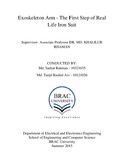| dc.contributor.advisor | Rahman, Dr. Md. Khalilur | |
| dc.contributor.author | Rahman, Md. Sadiur | |
| dc.contributor.author | Avi, Md. Tanjil Rashid | |
| dc.date.accessioned | 2015-09-01T05:53:08Z | |
| dc.date.available | 2015-09-01T05:53:08Z | |
| dc.date.copyright | 2015 | |
| dc.date.issued | 2015-07 | |
| dc.identifier.other | ID 10321035 | |
| dc.identifier.other | ID 10121026 | |
| dc.identifier.uri | http://hdl.handle.net/10361/4320 | |
| dc.description | This thesis report is submitted in partial fulfillment of the requirements for the degree of Bachelor of Science in Electrical and Electronic Engineering, 2015. | en_US |
| dc.description | Cataloged from PDF version of thesis report. | |
| dc.description | Includes bibliographical references (page 37). | |
| dc.description.abstract | Our team is designing an untethered, powered, upper body exoskeleton for use in the fields of
rehabilitation and therapeutic application, as well as occupations requiring augmented strength.
Though systems exist, past exoskeleton endeavors have led to bulky, expensive, invasive, and
tethered solutions. The challenge is to build an exoskeleton system that is inexpensive,
streamlined, and wireless. Our solution is unique in that it will be a low-cost, ergonomic device
actuated through sensors measuring the user’s motion. Through onboard sensing, the skeleton
can provide rich data, such as range of motion for use in physical therapy. This data can be used
by doctors and patients to more accurately track improvement over time. With its low cost,
hospitals could employ multiple devices and aid a larger audience of patients; the devices could
even be used at home for physical therapy, which would dramatically increase quality of life for
patients. Outside of physical therapy, augmented strength is applicable to physically intensive
occupations, as well as search and rescue operations. Each year, thousands of workers must take
leave due to injuries triggered by heavy lifting; with augmented strength, workers could avoid
harmful situations. | en_US |
| dc.description.statementofresponsibility | Md. Sadiur Rahman | |
| dc.description.statementofresponsibility | Md. Tanjil Rashid Avi | |
| dc.format.extent | 39 pages | |
| dc.language.iso | en | en_US |
| dc.publisher | BRAC University | en_US |
| dc.subject | Electrical and electronic engineering | en_US |
| dc.subject | Exoskeleton Arm | en_US |
| dc.title | Exoskeleton Arm : the first step of real life iron suit | en_US |
| dc.type | Thesis | en_US |
| dc.contributor.department | Department of Electrical and Electronic Engineering, BRAC University | |
| dc.description.degree | B. Electrical and Electronic Engineering | |
| dcterms.rights | BRAC University thesis are protected by copyright. They may be viewed from this source for any purpose, but reproduction or distribution in any format is prohibited without written permission. | |

